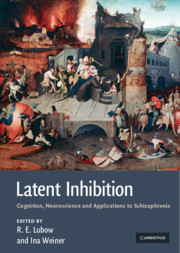Book contents
- Frontmatter
- Contents
- List of contributors
- Preface
- 1 A short history of latent inhibition research
- Current topics in latent inhibition research
- 2 Latent inhibition and extinction: their signature phenomena and the role of prediction error
- 3 Inter-stage context and time as determinants of latent inhibition
- 4 Latent inhibition: acquisition or performance deficit?
- 5 Latent inhibition and learned irrelevance in human contingency learning
- 6 Associative and nonassociative processes in latent inhibition: an elaboration of the Pearce–Hall model
- 7 From latent inhibition to retrospective revaluation: an attentional-associative model
- 8 Latent inhibition and habituation: evaluation of an associative analysis
- 9 Latent inhibition and creativity
- 10 The phylogenetic distribution of latent inhibition
- 11 The genetics of latent inhibition: studies of inbred and mutant mice
- 12 A comparison of mechanisms underlying the CS–US association and the CS–nothing association
- 13 The pharmacology of latent inhibition and its relevance to schizophrenia
- 14 Parahippocampal region–dopaminergic neuron relationships in latent inhibition
- 15 Latent inhibition and other salience modulation effects: same neural substrates?
- 16 What the brain teaches us about latent inhibition (LI): the neural substrates of the expression and prevention of LI
- 17 Latent inhibition in schizophrenia and schizotypy: a review of the empirical literature
- 18 A cautionary note about latent inhibition in schizophrenia: are we ignoring relevant information?
- 19 Latent inhibition as a function of anxiety and stress: implications for schizophrenia
- 20 Nicotinic modulation of attentional deficits in schizophrenia
- 21 Latent inhibition and schizophrenia: the ins and outs of context
- Summary and conclusions
- Index
- References
14 - Parahippocampal region–dopaminergic neuron relationships in latent inhibition
from Current topics in latent inhibition research
Published online by Cambridge University Press: 04 August 2010
- Frontmatter
- Contents
- List of contributors
- Preface
- 1 A short history of latent inhibition research
- Current topics in latent inhibition research
- 2 Latent inhibition and extinction: their signature phenomena and the role of prediction error
- 3 Inter-stage context and time as determinants of latent inhibition
- 4 Latent inhibition: acquisition or performance deficit?
- 5 Latent inhibition and learned irrelevance in human contingency learning
- 6 Associative and nonassociative processes in latent inhibition: an elaboration of the Pearce–Hall model
- 7 From latent inhibition to retrospective revaluation: an attentional-associative model
- 8 Latent inhibition and habituation: evaluation of an associative analysis
- 9 Latent inhibition and creativity
- 10 The phylogenetic distribution of latent inhibition
- 11 The genetics of latent inhibition: studies of inbred and mutant mice
- 12 A comparison of mechanisms underlying the CS–US association and the CS–nothing association
- 13 The pharmacology of latent inhibition and its relevance to schizophrenia
- 14 Parahippocampal region–dopaminergic neuron relationships in latent inhibition
- 15 Latent inhibition and other salience modulation effects: same neural substrates?
- 16 What the brain teaches us about latent inhibition (LI): the neural substrates of the expression and prevention of LI
- 17 Latent inhibition in schizophrenia and schizotypy: a review of the empirical literature
- 18 A cautionary note about latent inhibition in schizophrenia: are we ignoring relevant information?
- 19 Latent inhibition as a function of anxiety and stress: implications for schizophrenia
- 20 Nicotinic modulation of attentional deficits in schizophrenia
- 21 Latent inhibition and schizophrenia: the ins and outs of context
- Summary and conclusions
- Index
- References
Summary
Historically, the suggestion that dopaminergic (DAergic) neurons are involved in the latent inhibition (LI) phenomenon is linked to psychopharmacological studies carried out by two laboratories reporting an attenuation of LI responses in animals (rats) treated with the indirect DAergic agonist d-amphetamine, after chronic (Solomon, Crider, Winkelman et al.,1981; Weiner, Lubow & Feldon, 1981, 1984) or acute administration (Weiner, Lubow & Feldon, 1988). Involvement of DAergic neurons in LI was further supported by data showing that the LI attenuation induced by d-amphetamine was reversed by the concomitant administration of the neuroleptic chlorpromazine (Solomon et al., 1981), and by subsequent studies showing a facilitation of LI expression after administration of haloperidol (Weiner & Feldon, 1987; Weiner, Feldon & Katz, 1987), a well-known typical neuroleptic with a potent blockade action on DA receptors. Since these first studies, the reversal of the d-amphetamine-induced LI reduction by DAergic antagonists has been found in different LI paradigms after administration of several atypical neuroleptics, including olanzapine (Gosselin, Oberling & Di Scala, 1996) and clozapine (Trimble, Bell & King, 1998; Russig, Murphy & Feldon, 2002). In other respects, enhancement of LI expression has also been reported, with the atypical antipsychotics displaying a selective blockade action on D2 receptors such as sulpiride (Feldon & Weiner, 1991) or remoxipride (Trimble, Bell & King, 1997), whereas selective D1 antagonists were found to have no effect on LI phenomenon (Trimble, Bell & King, 2002).
- Type
- Chapter
- Information
- Latent InhibitionCognition, Neuroscience and Applications to Schizophrenia, pp. 319 - 341Publisher: Cambridge University PressPrint publication year: 2010
References
- 3
- Cited by



